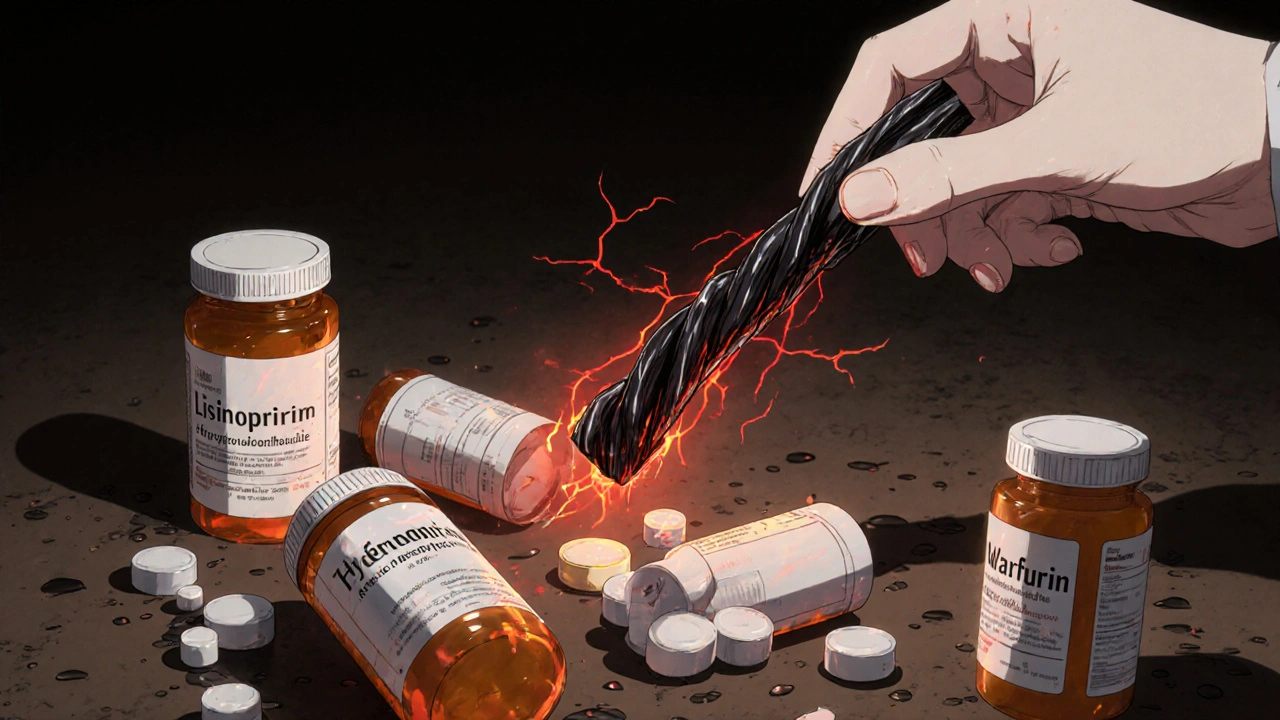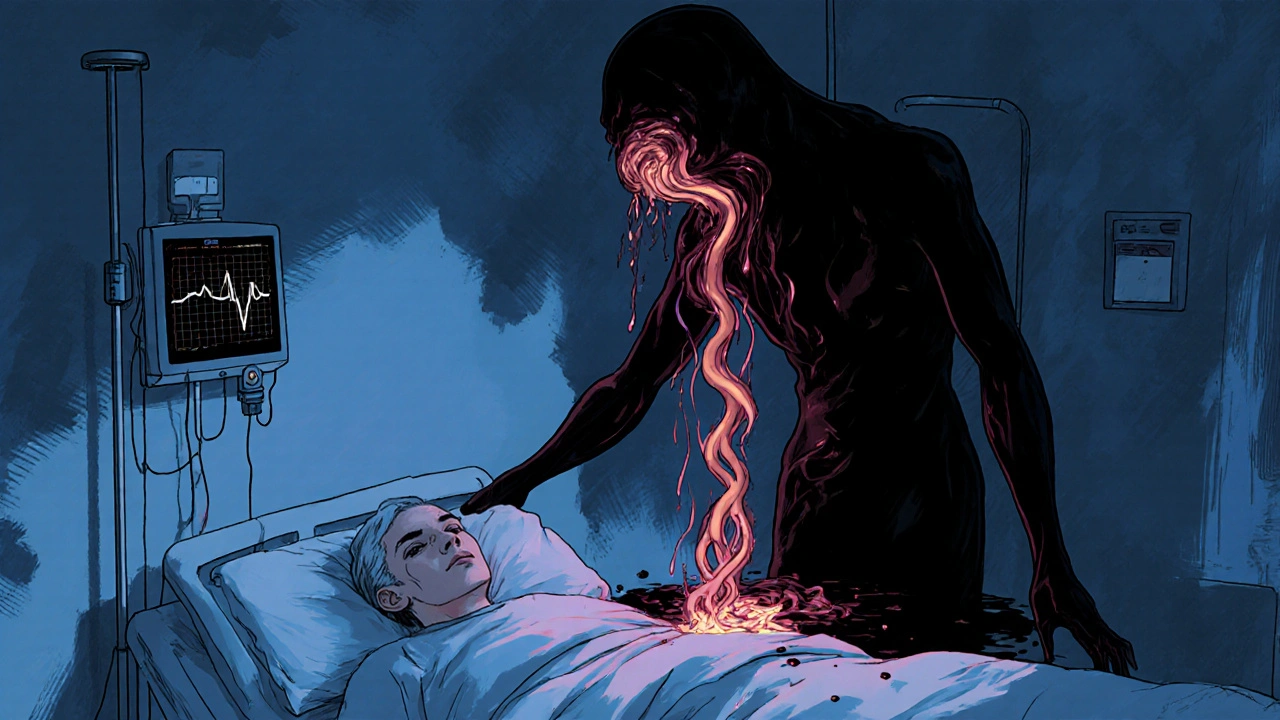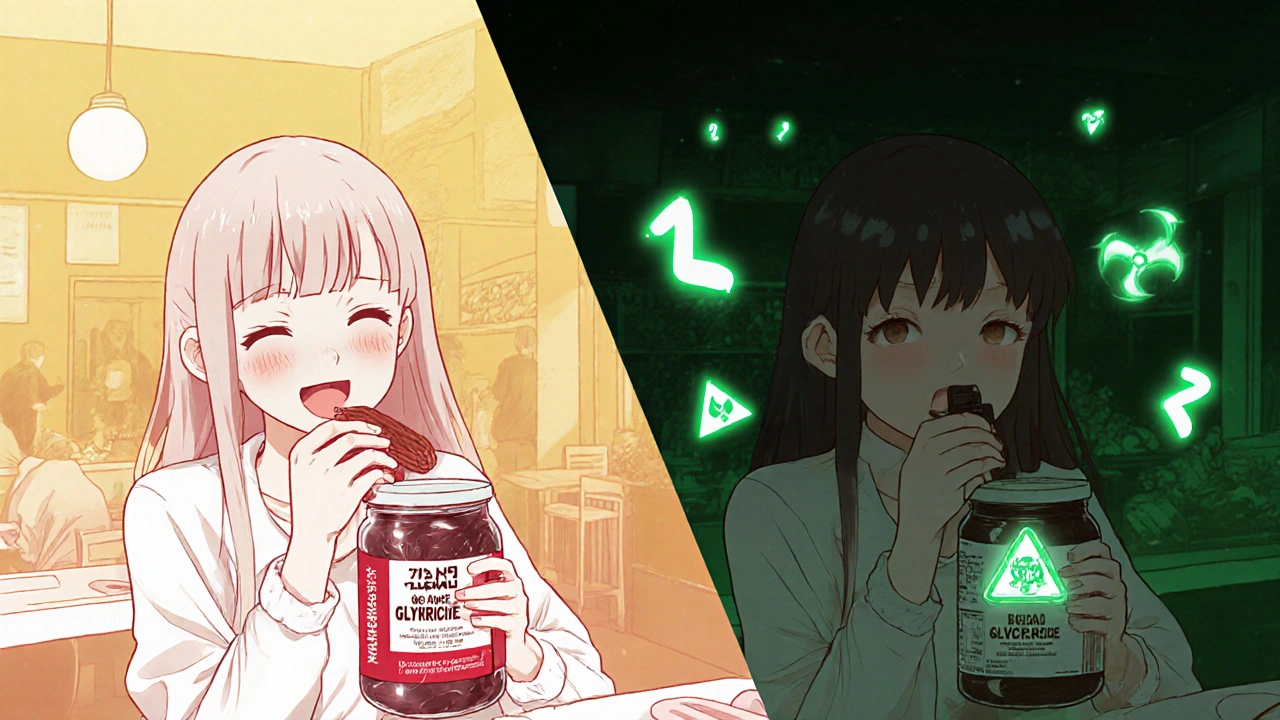Licorice and Medications: Unexpected Interactions with a Common Candy
 Nov, 22 2025
Nov, 22 2025
Licorice Intake Risk Calculator
Based on FDA guidelines: Daily glycyrrhizin intake should not exceed 100 mg for adults without health conditions, and 50 mg for those on certain medications.
Note: Effects can persist for days after consumption ends.
Most people think of licorice as just a sweet, chewy candy-something you grab at the checkout counter or share with kids during a movie night. But if you’re taking any kind of medication, that little black stick might be doing more than satisfying a craving. It could be quietly messing with your blood pressure, draining your potassium, or even undoing the effects of your prescriptions. And you probably have no idea.
What’s Really in Licorice?
Not all licorice is the same. The real stuff comes from the root of the licorice plant (Glycyrrhiza glabra), and its main active ingredient is glycyrrhizin. This compound is what gives licorice its distinctive flavor-and its powerful, sometimes dangerous, effects on your body. Traditional black licorice candy can contain anywhere from 0.5% to 2% glycyrrhizin. That means a single 50-gram bag might have 100 to 200 milligrams of it. And if you’re eating a few bags a week? You’re hitting the upper limit of what’s considered safe.Here’s the catch: many products labeled "licorice" aren’t real licorice at all. In the U.S. and elsewhere, anise oil is often used to mimic the flavor because it’s cheaper and doesn’t carry the same risks. So if you’re eating red licorice, or even some black varieties, you might be fine. But if you’re buying "real licorice" from a health food store, herbal supplement, or imported candy-especially from Europe-you could be consuming far more glycyrrhizin than you realize. Labels rarely say how much.
How Licorice Changes Your Body
Glycyrrhizin acts like a fake version of aldosterone, a hormone your kidneys use to control salt and water balance. When it binds to receptors in your kidneys, your body starts holding onto sodium and flushing out potassium. That sounds harmless, until you realize what that does to your blood pressure and heart.Low potassium (hypokalemia) can cause muscle cramps, fatigue, and irregular heartbeat. Sodium retention leads to fluid buildup-swollen ankles, weight gain, and high blood pressure. In one documented case, a 47-year-old man ate 200 grams of licorice daily for three weeks. His blood pressure shot up to 210/120. His potassium dropped to 2.6 mmol/L (normal is 3.5-5.0). He needed hospitalization.
This isn’t rare. Between 2010 and 2020, the FDA recorded 147 adverse events linked to licorice. Over 40% involved high blood pressure. Nearly 30% involved dangerously low potassium. And these are just the cases that got reported.
Medications That Get Dangerous When Mixed With Licorice
If you’re on any of these medications, licorice isn’t just a snack-it’s a risk.- Diuretics (like hydrochlorothiazide or furosemide): These drugs help you pee out extra fluid, but they also lower potassium. Licorice does the same. Together, they can drop potassium to life-threatening levels. One patient on a water pill developed potassium levels below 3.0 mmol/L after eating licorice daily.
- Antihypertensives (like lisinopril or losartan): These are meant to lower blood pressure. Licorice raises it. A Reddit user reported his BP jumped from 120/80 to 165/95 in just three days after eating 30 grams of licorice daily while on lisinopril.
- Fludrocortisone: This steroid mimics aldosterone. Adding licorice to it is like pouring gasoline on a fire. One man developed panic attacks and blood pressure over 200/110 after eating licorice while already taking this drug.
- Warfarin and other blood thinners: Licorice can either make warfarin work too well (raising bleeding risk) or reduce its effect, increasing clot risk. One woman on phenprocoumon saw her INR drop suddenly after eating licorice-enough to trigger a stroke warning.
- Digoxin: Used for heart rhythm problems. Low potassium makes digoxin toxic. A 2002 case showed a patient developed digoxin toxicity after licorice consumption, with potassium at 2.8 mmol/L.
- Metformin: Animal studies suggest licorice may reduce its effectiveness. Human data is still limited, but it’s enough to warrant caution in people with diabetes.
And here’s the twist: some licorice compounds can speed up how your liver breaks down drugs, while others slow it down. So even if your medication isn’t directly affected by potassium or blood pressure, licorice might still alter how much of it stays in your system. That’s why Memorial Sloan Kettering warns that licorice could interfere with drugs like cyclosporine, tacrolimus, and even some antidepressants.

Who’s at Risk?
You don’t have to be a licorice addict to be in danger. The European Food Safety Authority says healthy adults should not exceed 100 mg of glycyrrhizin per day-about two 50-gram bars of strong black licorice. But if you’re over 60, have high blood pressure, heart disease, kidney problems, or are pregnant, you’re far more sensitive. Even a small amount can cause problems within days.And here’s something most people don’t know: the effects don’t go away right away. Glycyrrhizin sticks around in your body for days after you stop eating it. So if you had a few pieces last week and now your BP is spiking, it might not be coincidence.
What About Deglycyrrhizinated Licorice (DGL)?
DGL is a version of licorice with most of the glycyrrhizin removed. It’s often sold for digestive issues like heartburn or ulcers. If you’re on medications and want the taste or digestive benefits of licorice, DGL is your safest bet. It contains less than 1% glycyrrhizin-far below the danger threshold. Just make sure the label says "deglycyrrhizinated" clearly. Don’t assume.
What Should You Do?
If you’re on medication and you like licorice, here’s what to do:- Check the label. If it doesn’t say "real licorice" or "glycyrrhizin content," assume it’s risky. Anise-flavored candy is safe.
- Limit intake. If you eat real licorice, don’t go over 100 mg glycyrrhizin per day-and even that’s pushing it if you’re on meds.
- Monitor your body. Watch for swelling, headaches, muscle weakness, or sudden changes in blood pressure or heart rhythm.
- Talk to your doctor or pharmacist. Most don’t ask about candy. But if you tell them you eat licorice regularly, they can check your potassium and blood pressure and adjust meds if needed.
- Switch to DGL if you want licorice flavor without the risk.
A 2021 study found only 37% of community pharmacists could correctly identify all major licorice-drug interactions. That means you might be the only one who knows what you’re eating-and what it could be doing to your meds.
The Bigger Picture
The global licorice market is worth over $1.3 billion, with supplements and candies driving most of the growth. Yet 78% of black licorice products don’t disclose glycyrrhizin content. Nearly all of them skip warning labels. In the UK, labeling is required if a product contains more than 100 mg per serving. In the U.S.? No such rule. Japan limits supplements to 100 mg/day. Europe is considering reclassifying high-glycyrrhizin licorice as a medicine, not food.Meanwhile, research continues. A 2025 review identified a new metabolic pathway linking licorice to water retention. Clinical trials are now testing whether your genes (like CYP2C9 or CYP2D6 variants) affect how you respond to glycyrrhizin. That means someday, your DNA might tell you whether licorice is safe for you.
For now, though, the message is simple: if you’re taking any kind of medication, especially for blood pressure, heart, or kidney issues, treat licorice like a drug-not a snack.
Can eating licorice raise my blood pressure even if I’m not on medication?
Yes. Even if you’re not on medication, consuming more than 100 mg of glycyrrhizin daily for more than two weeks can cause sodium retention and fluid buildup, leading to elevated blood pressure. This is especially true in people over 60, those with existing high blood pressure, or those with kidney problems. Symptoms include swollen ankles, headaches, and fatigue.
Is red licorice safe to eat with medications?
Generally, yes. Most red licorice in the U.S. and many other countries is flavored with anise oil, not real licorice root. That means it contains no glycyrrhizin and won’t affect your blood pressure or potassium levels. Always check the ingredients-if it says "anise flavor" or "artificial flavor" and doesn’t mention licorice root, it’s likely safe.
How long does it take for licorice to affect my medications?
Effects can show up in as little as a few days, especially with high intake. In documented cases, people developed high blood pressure and low potassium within two to three weeks of daily licorice consumption. But because glycyrrhizin stays in your system for days, even occasional use can cause issues if you’re sensitive or on certain drugs.
Should I stop eating licorice if I’m on blood pressure meds?
It’s safer to avoid it entirely. Licorice works against the purpose of most blood pressure medications by increasing sodium and fluid retention. Even small amounts can reduce their effectiveness. If you really want to eat it, talk to your doctor first and get your potassium and blood pressure checked before and after.
Are licorice supplements more dangerous than candy?
Yes, often much more so. Herbal supplements can contain 4% to 24% glycyrrhizin-far higher than most candies. A single capsule might deliver 100 mg or more. Since supplements aren’t regulated like drugs, labels often don’t list glycyrrhizin content. That makes it easy to accidentally overdose. Stick to DGL if you need licorice for digestive reasons.
What should I do if I think licorice is affecting my meds?
Stop eating licorice immediately and contact your doctor. Get your blood pressure and potassium levels checked. If you’ve been consuming large amounts for weeks, you may need monitoring or even treatment for low potassium. Don’t wait for symptoms to get worse-this is a preventable issue.
Next time you reach for that bag of black licorice, ask yourself: Is this a treat-or a hidden risk? When it comes to your medications, it’s better to be safe than sorry.

Ragini Sharma
November 23, 2025 AT 08:26ok but like… i ate a whole bag of black licorice last week and now my ankles look like inflated balloons?? is this why?? 😅 also my heart’s been doing the cha-cha lately. maybe i’m not just stressed??
Linda Rosie
November 24, 2025 AT 21:06Thank you for this meticulously researched and clinically significant post. The distinction between real licorice and anise-flavored products is critical for patient safety. I will be incorporating this into my pharmacist education module immediately.
Vivian C Martinez
November 26, 2025 AT 15:44Wow, I had no idea. I’ve been eating that black licorice for years thinking it was just ‘spicy candy.’ I’m on blood pressure meds too… I’m switching to DGL tomorrow. You’re a lifesaver. 🙏
Ross Ruprecht
November 28, 2025 AT 12:37bro why are we even talking about this? just don’t eat the black stuff. problem solved. also i like my candy how i like my life: dangerous and unregulated.
Bryson Carroll
November 28, 2025 AT 23:43Anyone who eats licorice without checking glycyrrhizin content is either naive or actively seeking a trip to the ER. The fact that this isn't federally regulated is a national disgrace. And don't even get me started on how people think 'natural' means 'safe' - that's the same logic that got us the e-cigarette epidemic. You're not a health guru, you're a walking pharmacokinetic disaster.
Dalton Adams
November 30, 2025 AT 05:15As a pharmacogenomics researcher, I can confirm that CYP2C9 variants significantly modulate glycyrrhizin metabolism. My own SNP data shows I’m a slow metabolizer - so I avoid it entirely. Also, FYI, DGL isn’t always safe - some brands use maltodextrin fillers that spike insulin. Always check the full ingredient list. 🧬
Karla Morales
November 30, 2025 AT 06:28🚨 WARNING: If you’re on warfarin and ate licorice this week, get your INR checked TODAY. I’m not joking. A friend had a TIA because she thought ‘it’s just candy.’ She’s 34. Don’t be her. 💔
Javier Rain
December 2, 2025 AT 00:22Listen up - this isn’t just about candy. It’s about taking ownership of your health. You’re on meds? Then you’re part of a medical team. And your candy drawer? That’s your first line of defense. Stop treating your body like a vending machine. DGL is your new BFF. Go buy some. Now. 💪